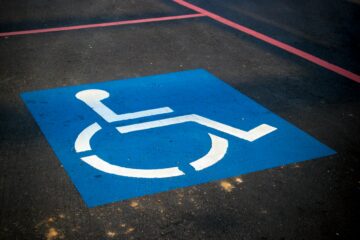by Rebecca Baumgartner

During the recent Christmas shopping rush, I had to park at the very back of a crowded Target parking lot. By the time I trekked across the lot and reached the door of the store, my knees felt a bit achy. Not a big deal. After about half an hour of walking around shopping, I was extremely tired, limping slightly, and desperately needed to sit down.
By the time I was halfway through the parking lot heading back to my car, I was hobbling and leaning heavily on my cart as a makeshift walker. With every step, something in my knees ground against something else that wasn’t giving way, like there were too many bones fighting for space in there, or as though my kneecap were being polished like a gemstone in a tumbler.
I’d recently been diagnosed with osteoarthritis in my knees, after more than a year of writing off the gemstone-in-a-tumbler feeling as a normal part of aging. In the Target parking lot, as I limped past the parking spaces designated for people with disabilities, I allowed myself to think for the first time, “Maybe I would not be feeling this bad if I had been able to park there.”
It appeared to me that this was a very straightforward problem with a clear solution, thanks to the Americans with Disabilities Act (ADA) of 1990: I could apply for a special parking placard that would let me park in one of the handicapped spaces every business is required to have.
I got home, medicated myself, and googled the application form for my state. Turns out this is a very simple form that merely requires a doctor’s signature. But what I soon discovered is that when a doctor diagnoses you with a degenerative disease, they are certainly happy to show you pictures demonstrating how messed up your bones are, prescribe you pain medication, and perform expensive surgeries on you – but they’ll be damned if they’ll sign a handicapped placard form for you.
***
“Get better soon,” the customer service rep on the other end of the phone said. I had just finished rescheduling one of my physical therapy appointments. “Thanks,” I said, already resenting having to thank this person for saying something thoughtless. I knew her intentions were good, but I couldn’t help wanting to stab her with a pencil just a little bit.
The reason I’d been going to physical therapy was to try giving my knees more time before something drastic needed to be done. There wasn’t going to be any “getting better.” In the best-case scenario, there would only be “getting worse slower than I otherwise would.”

This wasn’t the first time I’d encountered such obliviousness about chronic diseases from the very medical professionals tasked with treating them. The progress reports I periodically had to fill out after physical therapy sessions asked me to assess my physical functioning both before and after an injury that didn’t exist. Each week I had to report whether my knees had improved since my “injury,” which felt like answering the old trick question about whether you’ve stopped beating your wife.
My insurance company bugged me about this mythical injury as well, wanting me to attest that I hadn’t been in a car accident or workers’ comp situation. I’m not sure how one could think osteoarthritis could arise from a car accident, barring a Misery-type situation where a sadist is applying blunt force to your joints in a secluded cabin for months on end after said car accident.
Meanwhile, elsewhere on the progress report, I had to report the highest levels of activity I could do without pain. Running, something that my knees would now only allow me to do in a life-or-death situation, was listed as a “moderate intensity” activity, only one level above “household chores like vacuuming.” There was no intermediate stage between vacuuming your house and flat-out running to save your child’s life, a quite broad category that in my opinion includes 95% of all human movement. Nor was there a recognition that an activity requiring less aerobic effort than running might actually be more painful than a more cardio-intensive activity. For me, this includes climbing stairs, something I try at all costs never to do.
I don’t remember what the form considered more intense than running, because it radically did not apply to me; presumably it was things like fist-fighting a shark or manhauling across Antarctica while battling scurvy. Based on this strangely calibrated scale of exertion, my two favorite forms of exercise – walking my elderly dog for about half a block and getting up to reheat my coffee multiple times an hour – probably don’t even register as activities at all, even though both of them have, at various times, caused me to emit that sharp-intake-of-breath sound people make when something hurts.
It was obvious from the wording of the questions that the progress forms had been developed primarily for young, otherwise-healthy athletes, people who were experiencing temporary, fixable damage to some part of their body and had every reasonable expectation of getting back in the game. It’s not just thoughtless customer service agents and poorly-designed surveys, either; the focus on temporary, acute issues rather than chronic conditions is the norm.

For instance, in an interior design choice that seems to symbolize this mindset, my orthopedist’s office is decorated with murals and pictures of athletes moving in ways that I’ll most likely never be able to move again. I got the distinct sense while sitting in that waiting room full of injured basketball players and their moms that my problem was somehow less real or less serious than the problems of these important athletes who needed to get back to winning. I have a desk job. What’s so important that I need to do with my knees? Walk to my kitchen to heat up my coffee?
Probably this was all in my head, a self-created moment of medical imposter syndrome, but maybe this sense of being sidelined is also at least a little bit real and not just in my head. After all, unlike an injured athlete’s body, my body can’t truly be “fixed” in a way that doctors seem to find satisfying or interesting or profitable. Osteoarthritis is just one of those things that happens to lots of people. The recovery narrative doesn’t fit my situation, and for that reason it feels as though the healthcare system doesn’t want to make room for it. They just want me to take the pain meds and shut up.
***
After Christmas, I decided to apply for a handicap parking permit, technically called a “Persons With Disabilities Parking Placard” in Texas.
In my haste to solve this eminently solvable problem, I leapt right over the psychologically fraught realization that this decision represented a turning point in how I conceived of myself and my needs. Admitting you need extra help can be an emotional decision for some people. But not for me, at least not then. I wasn’t thinking about what this step might mean for me as a person. I just wanted the damn placard so I wouldn’t have to hobble through parking lots anymore. And the only thing standing in my way was my doctor’s signature.
I messaged my orthopedist. He was the one who had informed me in the course of a brisk 15-minute visit that it was impossible to reverse the joint damage that had already occurred and that it was not a question of whether or not the damage would progress, but simply how fast it would progress. So you can imagine my surprise when I messaged his office about the form and was told that he only approved applications for temporary placards, and only for patients who had had surgery recently, and even then, it would expire after six months – by which time I would have “recovered,” his spokesperson explained.
In the online chat, I calmly reminded the person who I assumed was a nurse (it was unclear what this person’s training was) that one can manage arthritis, but one does not recover from it. She responded, in the chilly tone of someone who is tired of dealing with your shit, “After the age of 40 or 50 we all have arthritis-like changes.” Even aside from the breezy disregard of my actual diagnosis and my particular circumstances, this statement is still off the mark, because the parking permit has nothing to do with age, only with the patient’s ability to walk. In fact, the application form doesn’t even ask for the patient’s date of birth.

And yet, I couldn’t help but feel as though being relatively young with an “old person’s disease” was working against me here. If I had shown up with the exact same joints and the exact same pain, but in the body of a 70-year-old, I genuinely think the conversation would have gone differently. It would be interesting to see how the nurse would respond to my request if she didn’t have access to my age. I’m not a lawyer, and I’m not trying to sue anyone here, but I would need a lot of convincing to see this refusal as anything other than age discrimination and/or an ADA violation.
Nor, by the way, is it necessary for the doctor to attest to the specific condition the patient has, or provide any documentation or coding to prove it. They merely have to attest that the person making the application has “mobility problems that substantially impair the person’s ability to ambulate.” It is up to the patient and doctor to decide together what counts as “substantial” impairment, a determination that is necessarily somewhat subjective, as all statements about pain are.
There is also nothing stating that the person must have recently undergone surgery, or any other similar restriction. The patient also does not have to use a wheelchair or cane to qualify. In fact, the patient does not even have to have a specific diagnosis to qualify (at least in Texas – each state handles this differently). The doctor merely needs to attest that the patient has an impaired ability to walk, and in the case of a permanent placard, that the impairment is not temporary. That’s it.

Here’s something I never thought I would say about my home state: This is an instance where Texas is actually on the underdog’s side, deliberately making the handicap permit application as broadly applicable and administratively unburdensome as possible for both the doctor and the patient. We have gargantuan parking lots that go past the visible horizon, and the state of Texas has reasonably concluded that people who struggle to walk across the various urban landscapes of this enormous state are entitled to get support. Physical ability is a spectrum, and for once my state has decided to err on the side of greater inclusivity within that spectrum. You get a lone gold star, Texas.
Meanwhile, the nurse I was asynchronously chatting with added, “We encourage patients with osteoarthritis to try as much conservative treatment as possible. Please let us know if you would like to discuss other pain relief options in addition to the prescription pain medication you are taking.”
Wait a second – joint pain that limits my ability to walk is apparently something so mundane that it does not warrant an accommodation, but if I want stronger prescription pain medication for it, all I have to do is say the word? Why is that the so-called conservative treatment option?
Question: Which of the following options is a more conservative approach to dealing with pain, in accordance with the best interests of the patient?
(1) Having the patient apply for a simple accommodation that would allow them to choose when they needed to minimize the activities that cause them pain, or
(2) Having the patient pay for and take prescription pain medication for years and deal with the associated side effects and drug interactions?
Follow-up question: Which option is more convenient for the doctor?

The nurse then had the nerve to add: “The findings on imaging are sometimes severe but there is no pain.” I decided not to be baited into proving my pain to someone who’s never examined me, so I ignored that grossly unprofessional remark and took a different approach.
“How do other arthritis patients get handicap placards?” I wrote back. The response was: “Unfortunately, I’m not sure how other patients go about getting a handicap license plate. I recommend you try asking your primary care physician instead.” Already I felt we were veering into an absurdity, since my primary care doctor was not the one who knew the most about the condition under discussion, but at that stage I still had the stamina for an administrative fight. Bring it on, I thought.
I did that thing all patients with more than one doctor have to do, even in the internet age: Explain to one doctor what another doctor said, like a UN translator negotiating a treaty between two nations without a lingua franca. My primary care team immediately told me the orthopedist should be the one handling it. Neither office wanted anything to do with this form. Everyone I spoke to acted as though I had shown up at a child’s birthday party and demanded they help me file my taxes.
After a series of soulless chat exchanges with faceless people who had never met me and were tasked with safeguarding the doctor’s time like the doorman in The Wizard of Oz, I was finally able to talk to my primary care doctor in person about it. Below is a rough approximation of how that conversation went.
“Yeah, we don’t really like to give those out very often,” he said with a sigh, as though I were a mediocre employee asking him for a raise after the company had had a tough quarter.
“Why is that?”
“Well, if someone just wants a temporary placard while they recover from an injury or surgery, that’s fine, but to get a permanent one, it’s this whole thing where you have to officially label the person as ‘disabled.’”
There was a pause here. I wanted him to explain why an administrative burden on his part was a valid reason not to give me a parking permit (again, I’m not a lawyer, but…). I was also curious why he thought being “officially labeled” as “disabled” was something I should necessarily want to avoid. It’s not a witch’s curse – call me whatever you want if it helps me get the accommodations I need. If I can wrap my head around the concept of being labeled as “disabled” for the purposes of parking, I don’t see what skin it is off his nose. Based on how he acted, you’d think his pay was being docked for every person labeled “disabled” in his patient roster.
“Well,” I said, when no explanation was forthcoming, “the state of Texas just says the person has to have trouble walking, and arthritis is one of the conditions that qualify someone for a permanent placard. It doesn’t say anything about having to have an injury or undergoing surgery.”
“Yeah, but we typically only do those permanent ones for people who are really disabled – like people missing limbs and so forth.”
I have zero legal training. But I know enough to know that there are lawyers out there who would love to talk to me at this point in my narrative.
I took a deep breath, tried to silence the interior monologue that was shouting “AT LEAST YOU HAVE LEGS, STOP WASTING HIS TIME,” and made a mental note to look up resources about invisible disabilities when I got home.
When I responded, I struggled to keep my voice and facial expression neutral and pleasant, something that I’ve learned comes across better when the other person is wrong and male. “The orthopedist said that my joint damage was the second-worst on the scale they use to measure joint degeneration. Depending on the day, it can be really painful for me to walk across a large parking lot.”

“You should probably ask your orthopedist to fill it out then.”
“I did, and he said to have my primary care doctor fill it out.”
“Sorry, we just don’t fill out this form except in very rare cases. It’s a policy we have.”
I know this brick wall; I’ve been here before. But something I’ve learned as I’ve gotten older is that it’s always worth at least trying to climb it, for your own self-respect if nothing else. “How do other arthritis patients deal with this?” I pushed. “Like, if someone in their 80s who struggled to walk showed up and asked for this form, would they not get it?”
“I know, I hear what you’re saying. But it’s just a policy we have. You should really talk to your orthopedist about it.”
Brandishing the term “policy” around, as though it’s the final word, unfortunately seems to be quite common in discussions about what accommodations someone is or is not going to get, as though it’s up to each clinic or business to decide how, or even whether, they want to comply with the law that day. According to a lawyer interviewed for this piece on NPR:
“When people with invisible disabilities request accommodations, Smithey says, some employers respond, ‘We don’t do that as a policy.’
‘And that’s a problem,’ Smithey says. ‘Because that person is not asking to partake of a benefit that’s offered in a policy; that person is asking for an accommodation they’re entitled to under the law.’”
So I went back to the orthopedist. I was still trying to be cooperative, in part because at this stage I still trusted my doctors more than I believed in my right to be an inconvenience. During these conversations, I asked myself questions like: “What do I deserve, exactly? Do I deserve to be in less pain on my own terms? Or do I just take the damn pills and shut up? Why do the powers-that-be consider it preferable to damage my stomach lining and kidneys rather than allow me to park closer to doors? Are we really at the point where I have to bully myself into being grateful that I have both legs, even though that’s completely irrelevant?”
“Hi there, I have another question,” I wrote in a chat to the orthopedist’s ambiguously qualified gatekeeper, trying to sound like a person who wasn’t exhausted and angry (women have to get really good at this). “So, I talked to my PCP about this and he said it was for your office to handle.”
What I didn’t say was: God forbid the two of you talk to each other and sort this out together rather than put more work on the person who’s in poor health.

And, by the way, ridiculously, in my case the two offices are part of the same health system, so you’d think they’d have, like, an interconnected system of computers of some kind that could pass messages between them easily so I wouldn’t have to play middleman.
There was no response to my chat message, but a few days later, I got a voicemail from someone at the clinic I’d never interacted with before whose job title implied she was part of the clinic’s legal team or patient complaints department. I knew she wanted to talk to me about “The Policy” (and would take advantage of the fact that I didn’t know all the ways it was superseded by The Law). I could already tell how condescending she would be. I could foresee the liability-minimizing runaround and customer service platitudes she would bury me under. I realized it was futile to try to persuade her and I decided not to waste my limited energy calling her back.
One of the many absurdities and indignities of our healthcare system is that you have to perform extraordinary acts of self-advocacy, organization, research, and emotional labor – not to mention excessive outlays of time and money – at a time in your life when you are, by definition, at your least capable of such exertions.
***
In the weeks since then, I’ve tried to learn more about this whole situation, which seems like it should have been able to be resolved in an afternoon. For instance, how common is it for people with arthritis and other invisible disabilities to face this kind of pushback? Do I have any recourse? Should I wait to try again until I’m in even more pain? What obscure incentives or threats are my doctors operating under, since it seems obvious that medical science is not foremost in their decision-making? During this process, I came across an article where I read the following:
“Dr. Fields says people should be comfortable bringing up this issue with their doctor, even if that conversation means you learn you don’t yet meet the requirements. ‘There’s no penalty for discussing this question,’ Dr. Lo says. ‘The worst thing that happens is that a patient is not eligible for the handicap placard.’”
No, Dr. Lo, I respectfully disagree. There is indeed a penalty for discussing this question. For starters, by undertaking this quest, I’ve probably branded myself as a “difficult patient” in a way that may subtly affect the care and attention I receive from these doctors in the future (though of course it shouldn’t). On top of that, there’s my own expenditure of time and energy relaying messages back and forth to members of the medical community like an arthritic carrier pigeon. There are all kinds of other intangible penalties associated with discussing this, including the emotional and social penalty of being told that I’m not “really disabled” and figuring out how to square that with my own lived experience.
It’s also not true that the “worst thing that can happen” is the disappointment of dealing with an administrative hurdle. For me, the “worst thing” is limping from a building back to my car, canceling any further plans for the day that involve standing up, and being couch-bound under heating pads for the rest of the day, with the words of the doctor echoing in my mind: “We only give these to people who are really disabled.”

No, the “worst thing” is how I slowly, over time, almost unconsciously, preemptively limit my outings and become complicit in the narrowing of my own independence so that I don’t have to limp to my car so often. How it becomes easier to stay home than go anywhere.
Or maybe the “worst thing” is a nurse looking at my date of birth and deciding that I’m too young to need accommodations typically used by older people, despite what my X-rays show and despite the fact that she knows nothing about me, having my pain called into question and being made to feel like a scammer who’s keeping resources from people who really need them.
Or perhaps the “worst thing” is being repeatedly told to “get better soon” when I won’t, or feeling obligated to educate my own healthcare team (under a very loose definition of the word “team,” since they are mostly unaware of each other’s existence) about what having a chronic condition means, and what invisible disabilities are, and the fact that a 39-year-old can, in fact, have a disorder that doctors are used to associating with people far more visibly frail than I am. “I’ve aged before having aged,” as disability advocate Kristina Kasparian puts it in her insightful piece “Flying Solo.”
This isn’t a niche issue. People with disabilities are the largest minority group in the country, and most people will deal with some form of impairment at some point in their lives. This point is driven home in Tom Scocca’s excellent piece in New York Magazine about his own medical misadventure, “My Unraveling”:
“This is what disability advocates have said all along, not that it usually sinks in: The able and the disabled aren’t two different kinds of people but the same people at different times.”

I have no idea what the next few decades of my life will look like, and I have a lot of questions, such as how many more times I’ll have to limp through a store. How long it will be until I need to get surgery. How much worse I’ll have to feel before my doctors are finally willing to use the dreaded word “disabled,” as though whispering Voldemort’s name. Which of the many effects of being on pain medications long-term I will eventually experience. To what extent the fragmentation and profit-hunger of the American healthcare system will subject me to more pain than is strictly necessary. How many more times I’ll have to reassure my insurance company that arthritis isn’t caused by car accidents. How many more pictures of athletes I’ll have to stare at in waiting rooms, gazing at all those soccer players smiling confidently in the assurance that their bodies will be taken seriously by their doctors so they can get back on the field.
All of that remains to be seen. And I’m now less confident than ever that the healthcare system will support me, or even operate in good faith, as I slowly navigate my way through it, making that sharp-intake-of-breath sound people make when something hurts.
